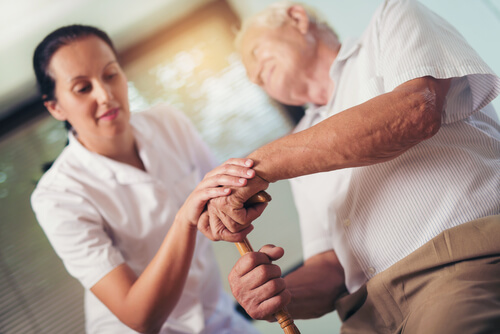
Page contents
- What is Parkinson's disease?
- What causes Parkinson’s disease?
- What are the three main symptoms?
- What are the early signs of Parkinson’s
- What are the treatments for Parkinson’s?
- Does Parkinson's affect life expectancy?
- What is Parkinson’s disease dementia (PDD)?
- What is Lewy body dementia?
- What support can you get?
Page contents
- What is Parkinson's disease?
- What causes Parkinson’s disease?
- What are the three main symptoms?
- What are the early signs of Parkinson’s
- What are the treatments for Parkinson’s?
- Does Parkinson's affect life expectancy?
- What is Parkinson’s disease dementia (PDD)?
- What is Lewy body dementia?
- What support can you get?
What is Parkinson’s disease?
Parkinson’s is a neurological condition that causes damage to parts of the brain. Currently the fastest growing neurological condition in the world, around 145,000 people in the UK live with Parkinson’s.
The disease comes under the umbrella term Parkinsonism, which covers several conditions with similar symptoms. Parkinson’s can affect thinking and movement and can manifest in a range of physical and psychological symptoms, such as tremor, stiffness and memory problems.
What causes Parkinson’s disease?
Parkinson’s is caused by a deficiency of the chemical known as dopamine. The reduction in dopamine happens when nerve cells in the part of the brain known as the substantia nigra die.
Dopamine plays an essential role in regulating movement of the body. A loss of these can cause many of the symptoms of the disease. Although it is not yet known why the nerve cells die, it is thought that both genetics and environmental factors play a part.
The symptoms of Parkinson’s disease start to appear when the brain can no longer produce enough dopamine to control body movements properly.
What are the three main symptoms?
The majority of people with Parkinson’s disease develop symptoms after the age of 50, but around 5 per cent start to experience symptoms when they are under 40 years old.
The three main symptoms are:
Tremor (involuntary shaking of parts of the body)
Slowness of movement
Muscle stiffness (rigidity)
Other common symptoms can include depression, sleeping problems and pain. People living with Parkinson’s can also experience balance issues and a loss of sense of smell (anosmia).
The symptoms of Parkinson’s do vary from person to person, including the severity of the symptoms as well as the type. In the same vein, the way the symptoms progress can also be highly individual. For most people, the condition can take several years to get to the point where it has a real impact on everyday life.
What are the early signs of Parkinson’s
As with many other progressive conditions, the early signs of Parkinson’s disease can be difficult to spot. This is heightened by the fact that symptoms can come and go from hour to hour, or be noticeable one day, but not the next.
Apart from tremor, slowness of movement and rigidity, early signs of the condition include:
Sleeping problems
- Certain symptoms, such as tremors, pain and restless leg syndrome can disrupt sleep and cause insomnia.
A loss of sense of smell
- A person with Parkinson’s may lose their sense of smell or notice that it is not as strong as it used to be.
Smaller handwriting
- Changes in the brain can cause movements to become smaller or less forceful, resulting in gradually smaller handwriting.
Bladder problems and constipation
- An overactive bladder is one of the most common bladder symptoms of Parkinson’s.
Depression
- People with Parkinson’s may experience extreme sadness or emotional emptiness before any other symptoms appear.
Fatigue
- Up to 50 per cent of people with Parkinson’s experience fatigue. This tiredness is thought to be caused by chemical changes in the brain.
Anxiety
- Feelings of unease, worry and fear can appear, particularly in the early stages.
If you, or a loved one, are experiencing any of the above symptoms, it doesn’t necessarily mean that it’s Parkinson’s, there are many other possible explanations.
If you are concerned, do not hesitate to speak to your GP. They will be able to offer you advice and, if necessary, refer you to a specialist and ensure you receive treatment as early as possible.
What are the treatments for Parkinson’s?
Although there is currently no cure for Parkinson’s, there are a range of treatments available to help manage the condition, relieve symptoms and enable people to maintain a good quality of life for as long as possible.
After diagnosis, you should receive a care plan which has been discussed between you, your family members and healthcare professionals and includes which treatments are recommended for you. This could change over time, so if you have any questions or concerns, don’t be afraid to ask.
The treatments for Parkinson’s disease include:
Therapies
Supportive therapies which can help you manage the condition include physiotherapy, occupational therapy, speech and language therapy and dietary advice.
The therapies can, for example, help relieve muscle stiffness and make moving easier to enable you to be more independent.
Medication
Medication can be used to reduce the main symptoms of the disease and most people will receive this as part of their treatment.
Levodopa is a medication which is absorbed by the nerve cells in your brain, which in turn becomes chemical dopamine which the body needs to control movement. Most people living with the disease will need levodopa at some stage.
Other medication includes dopamine agonists (a substitute for dopamine) and monoamine oxidase-B inhibitors (used to block the substance which breaks down dopamine).
Surgery
Some people may undergo a type of brain surgery known as deep brain stimulation to ease symptoms. The surgery involves implanting a pulse generator into your chest wall which is connected to specific areas of the brain.
The pulse generator produces an electric current to stimulate the part of the brain that is affected by the disease.
Does Parkinson’s affect life expectancy?
Parkinson’s is progressive, meaning that a person’s symptoms will worsen as time goes on and may make daily life more and more difficult. There is currently no cure for the condition, but there are treatments available to help people manage and reduce symptoms, such as physiotherapy and medication.
Although Parkinson’s does not generally make a difference to a person’s life expectancy, advanced symptoms can result in increased disability and poor health, making daily life a challenge for people living with the condition and putting them at an increased risk of other health risks such as infection.
What is Parkinson’s disease dementia (PDD)?
There are two different types of dementia associated with Parkinson’s. As they share similar symptoms, these types of dementia are often referred to interchangeably, but there is a clear difference.
A diagnosis of Parkinson’s disease dementia will typically be given if a person starts experiencing problems with their movement, such as a tremor or muscle stiffness, at least a year before any signs of dementia occur.
What is Lewy body dementia?
A diagnosis of Lewy body dementia will typically come if a person experiences symptoms of Parkinson’s at the same time or just before their symptoms of dementia.
Lewy body dementia is thought to affect 10 to 15 percent of people diagnosed with dementia, but it’s important to note that not everybody with this type of dementia will experience symptoms of Parkinson’s.
Lewy body dementia has two subtypes, which affects people’s thinking and movement and can cause a range of other symptoms, including hallucinations.
Aside from the well-known risk factors such as age and a family history, it’s still unclear exactly how Parkinson’s and dementia are linked. Research is ongoing to learn more about the connection, with the hope of finding further treatments for people living with both conditions.
What support can you get?
If you need care due to Parkinson’s, you can request a Needs Assessment from your local authority. Social services will then look at your needs and may cover the costs of services you need to manage symptoms or help you with daily life.
These can include home adaptations, which your local authority should cover up to a sum of £1,000 if you have been assessed as needing it.
There are various ways to pay for care, and you may be entitled to benefits to help you with the costs. Read our guide to paying for care at home to find out more.

